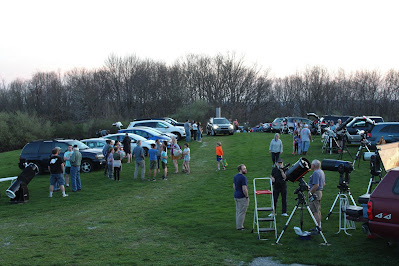Welcome to a night under the stars. If this is your first time visiting a star party, here are a few guidelines.
Star parties are held to allow the general public access to the telescopes owned by astronomy clubs and astronomers. The goal is to introduce you to the night sky and astronomy. On a good night you can expect to see double stars, galaxies and nebulas along with the moon, planets and satellites. Every time you visit one, different things can be seen.
The telescopes are set up there for you to observe through. All you need to do to look through these instruments is to ask! These are often very expensive, be careful when looking through them and follow the owners instructions. Don’t touch the optics or move the scopes. If you want to look at something else, ask and if possible, the owner will show you.
They will tell you what you are looking at and hopefully be able to answer any questions you might have. If they don’t know the answer, chances are that someone else near-by will!
Weather plays a big part in star parties. If there are clouds in the sky, chances are the telescopes won’t be set up. Heavy clouds hamper viewing and the members don’t want any moisture getting onto the optics. So saying, rain will cancel these events. If the weather looks threatening, call the observatory before driving up!
(Observatory phone #’s are usually on the clubs web site)
If you have a telescope at home, bring it along. Most star parties have darker skies than those closer to the cities; this will enable you to see more than you normally do. If you’ve never used your telescope before, come up early, while the sky is still light, and someone will be able to help you set it up and explain how it works. If you have a pair of binoculars, bring them along also. You will be surprised at how many stars you can see through ordinary field glasses. Bring a lawn chair if you want, to just sit and enjoy the skies above.
If you are considering buying a telescope, a star party is a great place to see what is available. Compare the views you get through different styles and brands, ask the owners what they like about their scopes and what they would recommend.
Bringing a jacket and a hat and wearing long pants is suggested since the temperature quickly drops after sunset. Most star parties are held on hilltops and there is usually a slight breeze blowing!
There is no smoking or alcoholic beverages allowed near the telescopes and it’s best to leave your pets at home to avoid any problems.
Another important thing is, don’t bring a flashlight! Bright lights are frowned upon at star parties. If you don’t know how to dim your cars lights, please park near the entrance and walk up to the site, it’s won’t be far! This will preserve everyone’s night vision.
After being in the dark for awhile, your eyes become accustomed to the dim light. Your pupils open up to permit more light in, allowing you to see more. Just a brief glimpse from a white flashlight or a car headlight will cause your pupils to shrink. It will then take up to 20 minutes for you to regain the night vision you had before. Astronomers use red flashlights since this won’t cause your pupils to react.
Children are very welcome at star parties; we hope to instill the love of astronomy in them at an early age! Keep your children close at hand. Explain to them about how costly these instruments are and share the need to respect the equipment and the owners.
When you go on trips, check to see if there are any astronomy clubs in the areas you will be visiting. They will usually have the dates of star parties they have planned on their web sites. Major parks have star parties also, their skies are often much darker than what you experience normally and they want to share this with you. Check before you visit. Commonly, star parties are held during the summer months and whenever something special happens, such as eclipses or meteor showers. Keep an eye out for them and come up and visit!
Should you be bitten by the astronomy bug, members will be more than happy to tell you how you can join the club, anyone is welcome to join! You don’t need any expensive equipment, just your enthusiasm!
To find out more about the Pittsburgh club, the AAAP, their two observatories and their star party schedule, visit;
The night sky is a treasure which is often over looked; a
visit to a star party just might help you see what great things you’ve been
missing! Chances are, I'll be there and I’ll be watching for you! Be sure to say "hi"!


.jpg)


.jpg)




4 comments:
Don’t forget the Passport to the Universe program up and running again for ages 8-12 and the Junior Messier program for ages 14-18. Pre-Covid we had just under 100 kids enjoying this fun and educational free opportunity!
Diane Yorkshire
Great family activity.
Can't wait until I can make to one.
Post a Comment